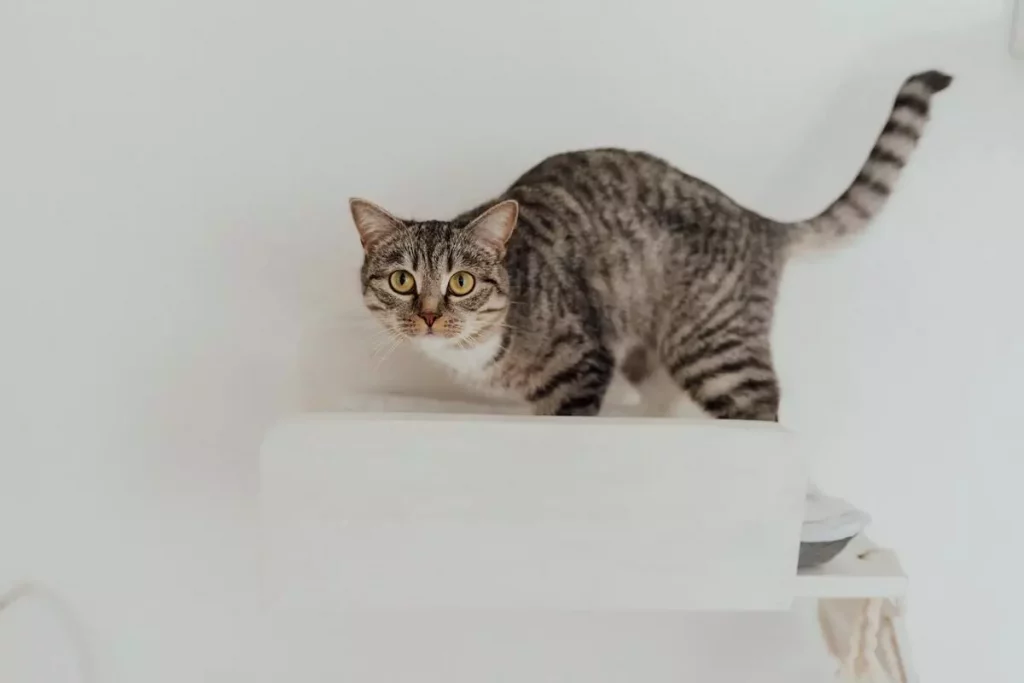Contrary to popular belief, a spay surgery is not exactly a piece of cake.
Sure, for vets spaying may be routine, but the recovery for your cat is anything but routine.
Naturally, we wonder about stuff like when it’s okay to take the cone off, how the incision should look like in a couple of days, and when it’s okay for your cat to be active again.
Your cat probably got spayed, jumped soon after that, and you’re left wondering whether or not that’s considered a disaster.
Believe it or not, jumping after being spayed is more common than many think.
Sometimes, cats are a little under the weather from the meds and surgery.
The anesthesia takes time to wear off and your cat’s behavior might be a little strange right after being spayed.
Other times, your cat is just incredibly bored and wants to finally jump on the couch again and walk off-leash.

Let’s dive into why that’s not a good idea, how bad jumping really is for your cat right now, and what you can do to prevent it.
For the sake of this article, I’ll refer to the female’s procedure as “spay” and to the male’s as “neuter” although the latter is technically the term for both. The term “castration” would be right for males.
My Cat Jumped After Being Spayed
If your cat jumped a few days after being spayed, it’s most likely not too big of an issue as long as the incision isn’t bleeding and your cat isn’t showing signs of discomfort such as whining or lethargic behavior.
Stay alert and contact your vet if you notice any of the following:
- Ripped sutures
- Bloody discharge or redness around your cat’s spay scar
- Lethargic behavior
- Whining, excessive panting, licking the wound
How long should you restrict your cat from bouncing around?
Jumping should be restricted for at least 10-14 days after being spayed, and 28 days until activity can return to normal.

The severity of this incident also depends on when and how your cat jumped.
If your cat jumped right after the surgery and perhaps even fell down due to a lack of coordination, it’s probably best to call your vet.
However, if your cat is a couple of days or even a week post-op and made a little greeting jump or jumped up on the couch, it’s usually nothing to worry about.
Again, consult your vet if you want to be sure.
Many cat owners report their cat happily bouncing around a couple of days after the surgery and while that may possible, it’s best not to take that gamble.
Restrict any forms of jumping for around 14 days after the spay procedure which includes:
- Greetings
- Excitement jumps
- Jumping up and down the couch
- Reaching for a tug toy or ball
- Playing with cats
- Climbing stairs
Just keep your cat calm, restrict the couch or any high places for a couple of days or carefully help your cat up, go on walks, and provide more mental stimulation
Mental stimulation is key to keeping your cat’s boredom at bay.
Many high-energy felines want to get going the day after the surgery but that should be a no-go.
That’s where mental exercise shines (i.e. puzzle games, snuffle mats etc.).
Climbing stairs is an issue for those living in apartments without elevators or houses with a second floor.
Try either carrying your cat up or letting her sleep downstairs.
How Do I Keep My Cat From Jumping After Being Spayed?
To stop your cat from jumping after being spayed, use a leash or crate inside the house, provide a comfortable sleeping spot on the ground, and offer mental stimulation to avoid frustration and boredom.
Avoid overly exciting your cat or leaving toys around that entice jumping.
With these tips, most jumping should be eliminated.
While the leash or crate is a last resort, the other options address the root causes such as wanting to get on the couch or bouncing around due to boredom.
My Cat Keeps Jumping After Being Neutered
The procedure for neutering males is a bit easier but if they keep jumping, it’s most likely due to discomfort or medication and can be restricted by crating or leashing them inside the house until they settle.
Leashing them might sound silly but it’s what many people do with kittens to avoid potty incidents or them gnawing at your precious carpet and whatnot.
You can also just try to stay with your cat, calmly pet her, and encourage settling down.
If all options are exhausted, you can place your freshly neutered cat inside a crate.
Crates are only temporary and your cat should be tired, well-fed, and only inside the crate for a limited time.
Right after the surgery, it’s not wise to place your cat inside the crate. While some might dig it and it’s more secure, many cats will want to be close to you after the anesthesia.
Consult your vet if jumping is atypical for your cat and she just won’t stop as that can be a sign of an internal issue or an issue with the sutures.
Can My Cat Jump On The Couch After Being Neutered?
Your neutered cat should not jump on the couch for 10-14 days after the surgery. If you lift your cat, have a low couch, or provide a little catty ramp, it might be possible earlier.
Yes, 14 days seems a little too cautious for some and they let their cat jump on the couch a couple of days after the surgery.
The biggest risk here is the sutures ripping open and just general pain for your cat and it’s best not to end up at the emergency vet for something as silly as climbing stairs or the couch.
If your furry friend wants a catty throne in the clouds, try offering a comfy bed on the ground where you can cuddle with your cat.



Leave a Comment